#worldbuilding religion
Text
Imagine if in the future there was a culture that viewed nuclear explosions and power as the ultimate sign of divinity. Like, that was the most powerful earthly expression of God/a god/the gods in their religion.
Entire fields of barren land turned into basically open air temples that are constantly nuked during worship as a way of honering their gods mabye sacrifices would be put within the blast radius to give them fully to the gods. Thousands watching from a safe distance in prayer.
Some temples might be filled with eradication to the point where worshippers have to wear hazmat suits to even be there, and in a way it keeps them at a safe distance from the divine. Perhaps the oldest and most honered priests enter sections of the temple nobody else can, because they're finally old enough so that they'll die before the cancer from the radiation has time to set in.
Mabye nuclear war would be their ultimate taboo. Using the power of heaven to wage war on earth. And the warnings of mutually assured destruction have shifted into warnings of divine punishment.
Mabye they see the ancients as foolish for fearing nuclear power. This is a place of honer, great deeds are esteemed here.
#196#my thougts#worldbuilding#urban fantasy#writing#my worldbuilding#my writing#nuclear war#nuclear weapons#nuclear#nuclear power#religion#worldbuilding religion#scifi writing#scifi worldbuilding#science fiction#science fiction writing#furture#far future#post apocalypse#post apocalyptic
164 notes
·
View notes
Text
According to my scant, second hand knowledge of the Jewish religion (idek the proper name, don't @ me), Catholicism, and Christianity, back when Jews were nomads, way before they settled down in one place, their god Yahweh was, in two words, a vicious dickhead of a storm god, and only after they settled down in Canaan did they try to calm him down by doing the theological equivalent of murdering the real wise and kind skydaddy god, El, blessed be his name, and then have Yahweh wear his flayed skin like some sort of grotesque mask and eat the rest, and that frankly goes pretty hard. Anyways I'm SOOO co-opting that into my writing, imagine worshipping the god that killed the supreme skydaddy and ate his corpse to gain his might. That's baller.
Edit: After further study, I have concluded that Yahweh was once an aspect of Qos, a mountain, weather and war god of the Edomite people. The ancient Israelites of Canaan then did a systematic eradication of every other god in the greater Canaan religion, including such gods as El and Asherah, Yam and Lotan, Arsu and Azizos, Aglibol, Malakbel, Yahribol, Bel, and Ba'al Hadad. In their shame after the crushing of the ancient Jewish kingdom under Babylon, the Jews, jealous in the banning of sacrifices to Yahweh, later wrote into their own Bible the banning of sacrifices to all gods. But Yahweh took sacrifices, and Yahweh took sacrifices in human infants, for Yahweh was a fellow Canaanite god just like the rest of them.
Edit 2: THIS POST IS ABOUT THE PRE-JUDAISM YAHWIST CULT OF THE ANCIENT CITY STATE OF ISRAEL AND HOW IT BECAME THE MODERN CULTS. Having to add this because some fucking [REDACTED] in the comments think that literal historical facts (with added hyperbole) is antisemitic somehow. They know who they are.
#worldbuilding#gods#worldbuilding religion#truth is stranger than fiction#but fr tho the ancient canaanites were nomadic raiders#and bandits too#and their god were similarly violent#only after they settled down did they try to smooth things out#the draft was made before oct 7#in the spirit of keeping it straight i won't comment on the newer news here#jewblr#jumblr
62 notes
·
View notes
Note
Do you have any advice for worldbuilding religions? I have an idea of what i want practice of a certain facet to look like, but beyond that I'm stuck
Yes!
A few major things to always think about when worldbuilding religion
Size of religion
Cultural influence
Rituals/Festivities
The first thing I try to decide is what tone am I gunning for, and what do I want religion to do/represent in my worldbuilding. I work from there. It decides how extensively I want to work on and plan.
Pantheons & Gods
Decide if the religion is Monotheistic or Polytheistic, and balance your pantheons
(Also note that monotheistic religions often times technically still have pantheons due to how the religions formed over time, take for instance Christianity, with its saints, prophets, god, great angels, and demons)
For polytheistic religions try to create a general idea of what role each god plays in the lives of its followers. A common thing people forget about, and a thing that plagued me with two years of plothole filling, is how do the believers use an overall pantheon.
Are believers separated into groups who worship a particular god, but also acknowledge the others?
Are believers set to primarily worship one god out of a pantheon, the others being sidelined in their beliefs?
Are believers worshipping the majority of the pantheon, perhaps viewing a handful as powerful necessary evils?
Are believers equally worshipping the entirety of the pantheon?
Festivities & Culture
If holidays aren't originating from historical events, they often derive from religion, mythology, and folklore. Big influential religions become intertwined with culture, whether people like it or not.
This could be Christmas going from various Pagan religion's celebration of the winter solstice to a Christian holiday celebrating Jesus' birthday to a national tradition of gift giving many celebrate despite not being Christian. Every country sees culture influenced by religion in one way or another.
Other examples IRL
Religious clothing & accessories: Hijab, fez, kapp, modest dressing, clergy robes, cross necklaces, etc.
Calendar & work day: Working the majority of the week except for Sunday, national holidays, length of the month, start of harvest, etc.
Laws & society standards: Isms, Anti-Cannibalism, cleanliness culture, food consumption rules, etc.
Rituals
Rituals are also a major thing people think of when going to worldbuild a religion. This is the praying, the blessing food at the table, the enchanting a knight's sword with holiness before they charge into battle, the sacrifice into a volcano, the donating entire sheeps to a god's altar...
Rituals in worldbuilding are what can help differentiate and make the worldbuilding unique! Game of Thrones, Six of Crows, and Metro are all popular series that utilize religion heavily in their hard worldbuilding. In soft worldbuilding we also see a lot of unique religion; Hollow Knight, Spirited Away, and Dark Souls.
Ruling out the rituals and their important to the worldbuilding can do wonders to making a religion feel more real for the world it is in
Conflict
Sadly with religion usually comes conflict. This includes Isms (racism, sexism, religion vs. religion). Either way religion can play a greater role in military, government, conflicts, and more.
Take for instance warrior religion culture! Whether it be the Norse Vikings of Europe, the Pagan Roman Soldiers of the early Roman Empire, the Christian Crusaders and the blood trail they left behind, or even deities of war seen all over the world throughout history
(Im a sucker for war gods in worldbuilding)
Religion can be conflict, and for us worldbuilders, conflict can be very fun to play with!
IRL Controversy
A growing difficulty with worldbuilding religion is what I call mimicry, religion bad, and censoring
Mimicry
It's easiest and often even advised to pull from what we know when creating anything. However there's a point where we're not jumping off the deep end enough, and sometimes unintentionally we just end up making a slightly altered copy of an already existing religion. This can not only be offensive to the religion or it's people, but also limiting to the worldbuilder's potential.
There are always moments where this can be intentional in worldbuilding, especially for Alternate History and futurism worlds that are just an extension of what we know. But if its not what you're going for its a major thing to try to avoid.
Religion Bad
For many people extremism has ruined religion, and this can bleed into their work positively and negatively. That's when we run into religion bad! Where every single time religion appears, it is only there to be an evil, a badness, a stain. (This an awful way to think about religion in general, including in worldbuilding) This can cause people to skip over cultural worldbuilding, as well as limit them by forcing them to never indulge in any potential goods religion can cause.
Censoring
Now taking the previous two in mind, don't hinder yourself! Modern day Puritan Culture and Cancel Culture makes this last part hard to stop yourself. Self censoring is becoming more and more common for creators of all types, including worldbuilders. If you want to something guttural and grim dark do it! If you want to do something gory and cult-like, do it! If you want to do something whimsical and Ghibli, do it!
#worldbuilding#redd answers#dezert answers#worldbuilding religion#writing religion#world building#world building religion
45 notes
·
View notes
Text



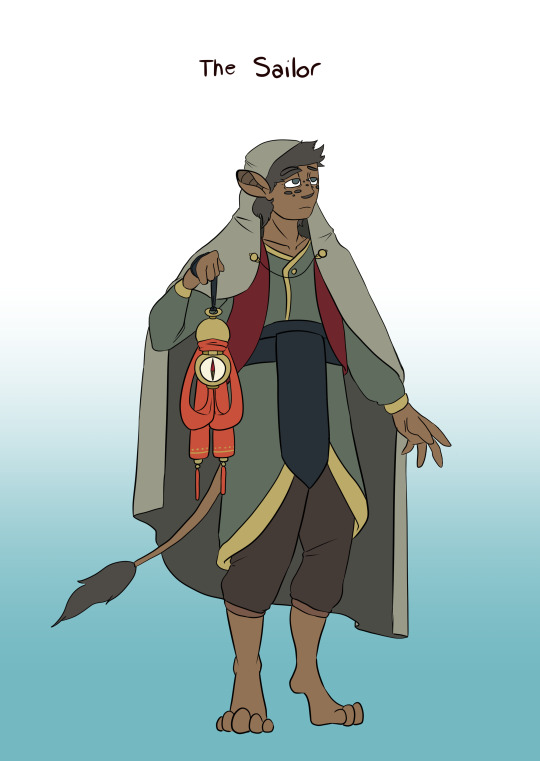

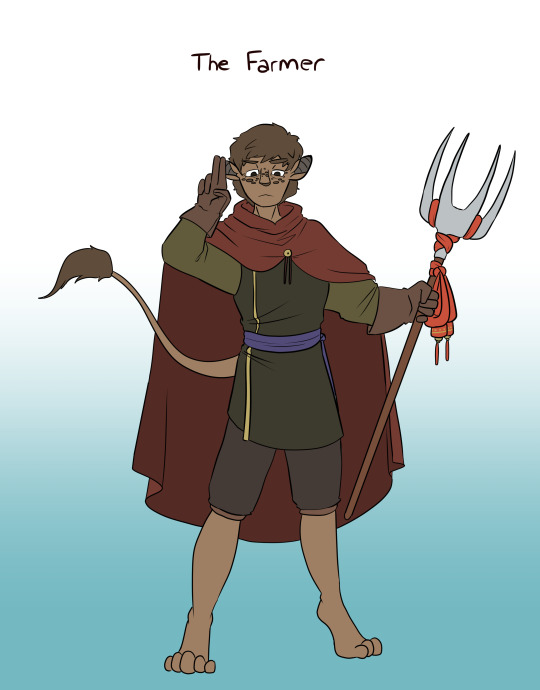


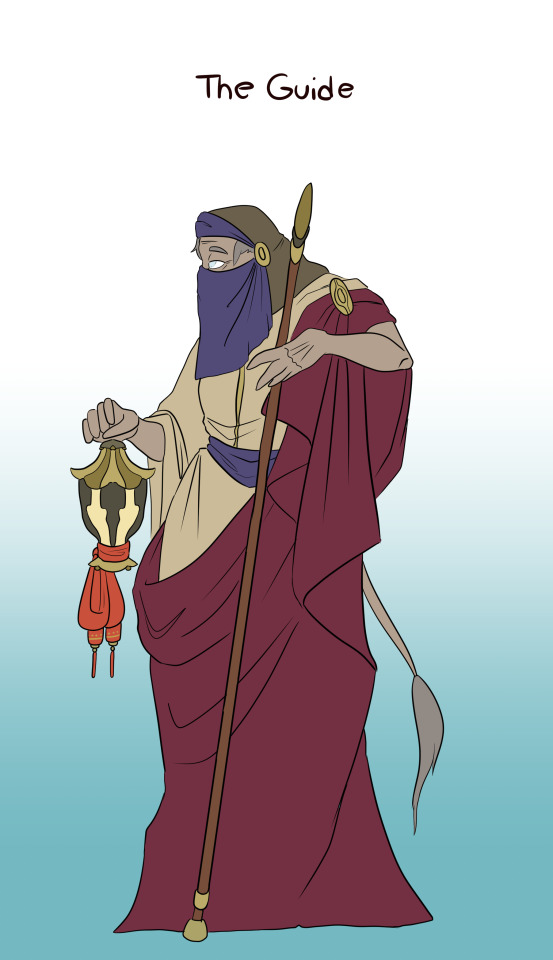
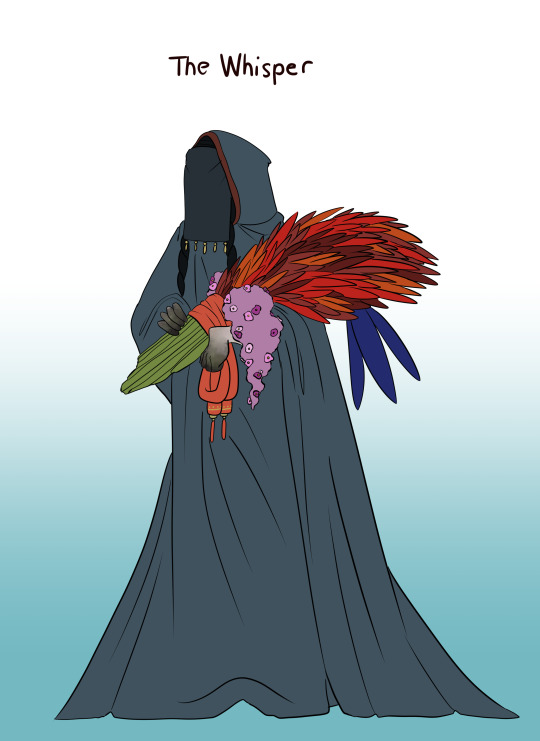

Behold, the primary religion of the United Islands! Lore under the cut!
Lore:
Behold, the great Ten Faced God! Or the Pantheon of Ten, if you subscribe to that belief.
Because, as is with history, the nature of the divine is a contentious subject in the United Islands. There are three main camps of thought:
The Ten Faced God asserts that there is one god, and that god changes forms throughout the year. They are one entity, although each form is not the same as each other. This is the newest interpretation, the currently dominant school of thought, and is practiced in most urban areas of the mainland and on the larger islands.
The Pantheon of Ten asserts that there are 10 different gods, with their own domains, who rise and fall in power throughout the year. They have relationships and a family tree (comment if you want to know more). This is the older of the two more common forms, and is practiced on the smaller islands to the south, and in some rural sections of the mainland.
The 10 Realms asserts that the gods are not entities at all, but a collection of spirits that serve under one of 10 divine domains people thing of as gods. This is the oldest form of the religion, only practiced anymore way out in the desert and in remote mountain villages, in small cults dedicated to specific spirits.
What all of these schools of thoughts agree on are the names and orders of the gods and their domains. In order there is:
The Shepherd: Also known as the Maiden, Queen, or Mother, the Shepherd is the goddess of fertility, animals, spring, and the soul. She is also known as the divine symbol of womanhood, motherhood, and children. She represents the love shared between a parent and child, and will strike down those who would bring harm to children. In the polytheistic model, she is the queen of the pantheon. Her divine symbol is the Shepherd's Crook.
The Dancer: Also known as the Paramour, Drunkard, or Trickster, the Dancer is the god of the arts, sex, emotion, games, and celebration. He is also the divine symbol of mischief, romance, creativity, and tricksters. He represents the fiery, passionate love in young relationships, and protects and tends to love wherever it may grow. His divine symbol is a basket of party favors, including wine, grapes, and fruit.
The Guardian: Also known as the Soldier, Sculpture, and Watchman, the Guardian is the goddess of war, the body, fire, and summer. She is also known as the divine symbol of strength, protection, and the land itself. She represents the love between a person and their country, and literally shaped the land to protect the people, according to mythology. Her divine symbol is her spear.
The Sailor: Also known as the Fisherman, Captain, or Storm, the Sailor is the god of the oceans, the weather, instincts, and fish. He is also known as the divine symbol of determination, the tides and currents, and the unpredictability of the world. He represents the love between a person and their craft, and will bless those in need of the drive to finish the job. His divine symbol is a compass.
The Merchant: Also known as the Gambler, Craftsman, or Surf (very controversial), the Merchant is the goddess of wealth, trade, luck, and commerce. She is also known as the divine symbol of fortune (both good and bad), workers, the artisans. She represents a love in the sense of aesthetic appreciation or infatuation and tends to follow flights of fancy whenever it strikes her. Her divine symbol is a coin purse.
The Farmer: Also known as the Father, King, or Reaper, the Farmer is the god of fertility, agriculture, work ethic, and autumn. He is also known as the divine symbol of manhood, fatherhood, and marriage. He represents the older, mature love between long time committed partners, and will strike down those who would threaten their own family, particularly their partner. In the polytheistic model, he is the king of the pantheon. His symbol is a pitchfork.
The Judge: Also known as the Debt Collector, Politician, or Balancer, the Judge is the goddess of justice, conscience, shelter, and leadership. She is the divine symbol of politicians, the courts, leaders, and even criminals. She represents the love between a person and society, and watches those who may abuse such society, both the criminals and ones who prosecute them. Her divine symbol is a balancing scale.
The Traveler: Also known as the Wanderer, Stranger, or Vagabond, the Traveler is the god of roads, the mind, winter, and knowledge. He is the divine symbol of curiosity, scholars, travelers, and storytellers. He represents the love between a person and the world around them, and is known to compel people to wander away from home. His divine symbol is his walking cane.
The Guide: Also known as the Weeper, Ferryman, or Mourner, the Guide is the god of time, rivers, the moons, and medicine. They are the divine symbol of the aging, frost, and endings. They represent the brotherhood love between two friends, ones who would die for each other. They are the divine protector of the sick, dying, and those who mourn for them. They are described as neither man nor woman, but something in-between. Their divine symbol is their lantern.
The Whisper: Also known as the Mist, Silent, or Shrouded, the Whisper is the god of death, sleep, and cycles. They are the divine symbol of mist, dreams, and the dead, as well as the end of the year. They represent the compassionate love one must have for themselves, and only is said to act upon the world during the last two days (or three if it's a leap year) of the year, collecting those who have died and take them back to the garden from which they were made. They are described as completely genderless. Their divine symbol is the death bouquet.
#ask blog#ask box open#send me asks#worldbuilding#fantasy worldbuilding#digital art#my art#worldbuilding ask blog#worldbuilding religion#nonbinary character#agender character
7 notes
·
View notes
Text
Level 1: Characters in a fantastical setting with no clear analogue of any real-world culture or religion celebrate Christmas; the implications of this are never examined
Level 2: Characters in a fantastical setting celebrate a secular, non-denominational mid-winter holiday which just coincidentally involves many of the same rituals and observances as Christmas
Level 3: Characters in a fantastical setting celebrate a mid-winter holiday commemorating an invented folk-hero whose mythos furnishes elaborate alternative explanations for various Christmas observances
Level 4: Characters in a fantastical setting celebrate Christmas because in spite of the setting's history otherwise bearing no resemblance to that of Earth, for some reason Catholicism still exists
Level 5: Whatever C S Lewis was on
9K notes
·
View notes
Text
Any advice for handling race in reincarnation situations?
@swamp-spirit asked:
I'm writing a story that includes characters being reincarnated with completely different appearances. It's a fantasy world, and most of the characters are being reborn in the same region, but I still want a range of skin tones and features in the main cast (this is a comic). I have weird feelings about a character being 'reborn' with notably lighter or darker skin, but it also feels implausible and lazy for people to Just Happen to have a similar appearance when the theology of the story doesn't support it. Characters being reborn, and taking out things specific to real life groups, what are the major things you'd want an author to read up on or take into account? (Note: there is not a 'white' looking ethnic group in this story)
I don’t think it’s a problem as long as the skin tones don’t have any correlation to the circumstances that they’re reincarnated into.
- SK
It’s an interesting question, because in most religions where reincarnation/ transmigration of the soul is a feature of “what happens after death”, remembering one’s past life is not really part of the package deal. From what you’ve written, it’s not clear to me where the “memory” of these characters’ lives are held. Is there a 3rd person omniscient narrator telling the audience who each person is in their next life or do the characters themselves retain memory of past lives?
Assuming this is your typical reincarnation scenario where characters retain no memory of previous lives, it doesn’t much matter. The next life is the next life. Who a person was in their previous life and that identity, in theory, means nothing to them. This also means whatever personality, values, experiences and so on they had in their previous life no longer has meaning. They are, in effect, another person. However, you say you feel awkward about the above which makes me wonder if characters are remembering past lives, in which case…
If you study pretty much any major Asian religion where reincarnation is a part of the belief system, having no memory of the previous life is par for the course. In present-day religions like Jainism, Sikhism, Hinduism and Buddhism, only “special” (I’m using the term very casually here) entities like bodhisattvas, guru, arihant, buddhas, etc. usually get to keep their memories, while the rest of us (literal) mere mortals are supposed to lose our memories between lives as a part of Samsara. In Hinduism, even the gods often forget their previous lives, unless their reincarnation had a targeted purpose (Like being born to defeat an evil entity).
For most people, it is only through prayer, devotion, meditation and accumulated virtuous/ good/ compassionate deeds that humans are thought to deepen their understanding of the nature of the universe, and thus have the capacity to remember past lives (I’m, again, paraphrasing very loosely here from several years worth of university history+religion courses).
This is why the isekai genre in Japan is largely regarded as a “cheat”/ parody genre of fantasy. The protagonist, according to common Japanese cultural beliefs, which are quite heavily grounded in Buddhism, is definitively “cheating.” Not to get too ironically biblical, the character’s success often comes from the forbidden knowledge borne of their previous life.
Thus, there are two ways I look at your characters’ predicaments:
It’s not technically reincarnation - not by the way most major world religions define reincarnation, anyway. You have people who died now inhabiting other bodies, but that’s not the same as the transmigration of the soul. Also, you want to delve into the weirdness (and maybe heaviness) of “Wow, I went to sleep with one face and woke up with another.” There are certainly stories about people who have had dramatic cosmetic plastic surgery, weight loss surgery, HRT, etc. and then experienced the difference in the “before” versus “after” of how their altered physical appearance makes them feel, as well as how other people treat them. Even if the community your characters are born into now differs from their previous community (Which I guess would make this more a “I traveled between dimensions, and my appearance altered in the process” sci-fi adjacent affair), their new life will still have social environments with differing attitudes towards human physical appearance that will affect your characters’ emotional states.
Isekai it up and play with the ridiculous contradiction of having past lives and differing memories of one’s appearance. Isekai manga, manhwa and webtoons all make use of this trope heavily, especially with protagonists who experience a “glow-up” (Ex. Going from a Plain Jane OL to beautiful fantasy heroine) or, by contrast, protagonists who end up in very different forms from their original lives (Tensura, I’m a Spider, So What?). I’d be creative and go even more granular. Being able to tan after a lifetime of getting sunburns or no longer needing glasses might be nice, but what if the new body lacks the enzymes to process dairy or alcohol? What about dealing with differences in hair texture? Skincare routines? What about living life as a very tall person after being quite short or vice versa? What if you bumped into an acquaintance from your previous life, and one of you clearly got a more “coveted” reincarnation? See how far of an extreme you can take this idea until it feels too uncomfortable or ridiculous.
Marika.
402 notes
·
View notes
Text
What happens in the Dolorian church in Martinaise is a profound bit of worldbuilding. At first Elysium seems like a normal, secular world, and if anything it's surprising how absent religion is from it. Liberalism has become the religion. The only real reminder that Moralism was once a fully functioning world religion is the abandoned and broken church west of the lock.
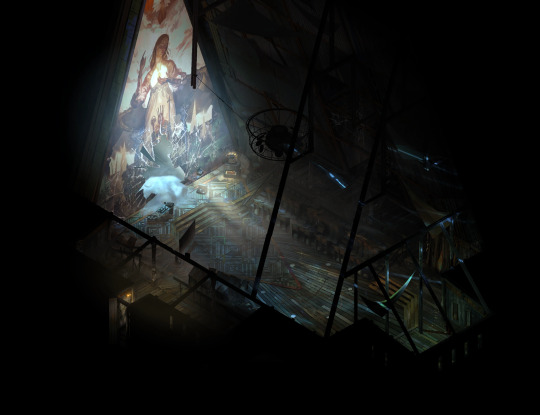
But learning about the pale point, the history of the churches, it makes sense now. The pale is directly interacting with human thought and society because they are both manifestations of information in the universe, in an evolving dialectic. Dolores Dei pulled information from the future and literally expanded the world by inspiring others with her dream. She was, by the standards of our world, a prophet. The churches, built around nascent points of pale particles, are a social attempt to control the pale through the collective act of ritual dreaming. By dreaming the divine, humanity pushes back the death of the world, for a moment.
By the time the game takes place, that side of Moralism is long dead. The churches have been abandoned and their function forgotten. Moralism has degenerated into liberalism. The Revolution was a moment of mass dreaming, of the future manifesting itself. It was the best hope to push back the Pale, but the MoralIntern crushed it, and restored global stagnancy. Growing entropy is accelerating the consumption of the world by the Pale, and no-one knows what to do because there is no future, only past.
Harry though, depending on how you play him, has the potential to start the reversal of this process, if just in Martinaise. The man who has effectively dedicated himself to a kind of monastic worship of the Pale (unknowingly) is the first one to start the process. (Never give anyone too much credit, even Harry.) But if Harry helps the homeless ravers start a club in the Church, he is effectively helping to start a new ritual community with the same properties as the old Moralist Church, right under the pale point.
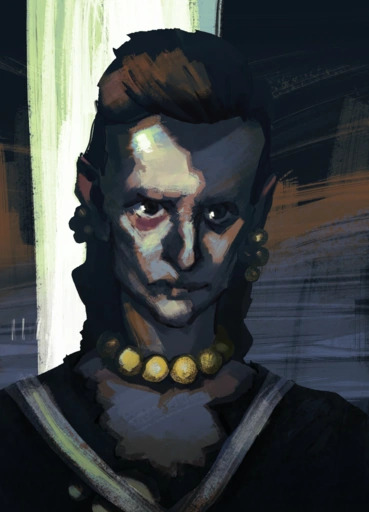
If you get Noid to warm up to you, you learn he's a kind of organic existential philosopher. He even discourses with Tiago. He and the others don't just party as a hedonistic act, they maintain partying as a kind of ritual act of life affirmation and contemplation, an attempt to transcend themselves and realize something new and powerful. In short, they are reaching into the future to create something new. It's ridiculous 90s Euro club music, but the way they do it it's as ritually powerful as any church service.
This ties into the more general theme of Disco Elysium, that the human power to dream of a new future and then collectively act to bring it about is a powerful act of creation that pushes back the boundaries of the universe, and is necessary for our species to even survive. To crush the revolution, to crush democracy, is to crush the future. Elysium has killed God, but they haven't gotten to the next stage of becoming gods.
Dolorian humanism ironically does not end up elevating human beings. Only the communards had a chance at elevating humanity to a level of creative consciousness that would allow them to tame the Pale the same way they used to with religion. And the revolutionaries, even though the Moralists never recognized them as such, were likely pulling from the future as much as Dolores Dei. Kras Mazov will never be recognized as an Innocent, but in terms of prophesying and inspiring people with a dream which could push back the Pale, he effectively was.
Now with the revolution at a low point, the world is in a kind of existentialist limbo, lacking the conviction of faith in either the divine or the future. The old is dead, but the new cannot be born. What happens in Martinaise is the beginning of the return of that faith.
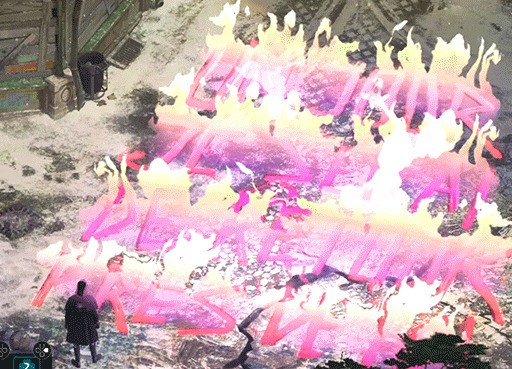
#Disco Elysium#philosophy#religion#existentialism#Friedrich Nietzsche#Kras Mazov#Harry du Bois#Noid#Tiago#Dolores Dei#socialism#capitalism#liberalism#writing#worldbuilding
1K notes
·
View notes
Text

Been keeping this away for long since its a very out of context specific stuff.
These are the Heads - the mostly spiritual leader of the central Foru micro-state collective. Their role is to be a guide for all the leaders (archs) in central Foru and speak for all of them on an international level. They also bless lands and people and generally are well-liked by them. They can make big decisions, but it's ultimately on the archs if they comply (but the pressure is strong).
Every head has a more specialized role, each representing a 'sense' of their one shared soul (hearing, seeing, touch, thought...) and people they are patrons to (the old, the "rich", the leaders, the priests...). Each central Foru micro-state usually has its favorite head that they want to see the most in their community when bringing them news or blessings.
here are closeups
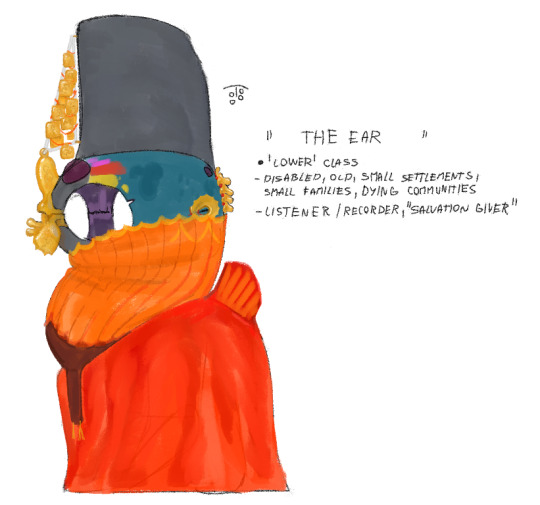
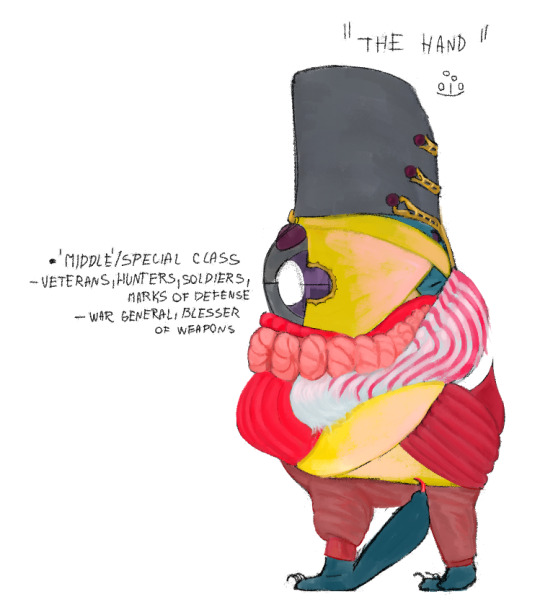
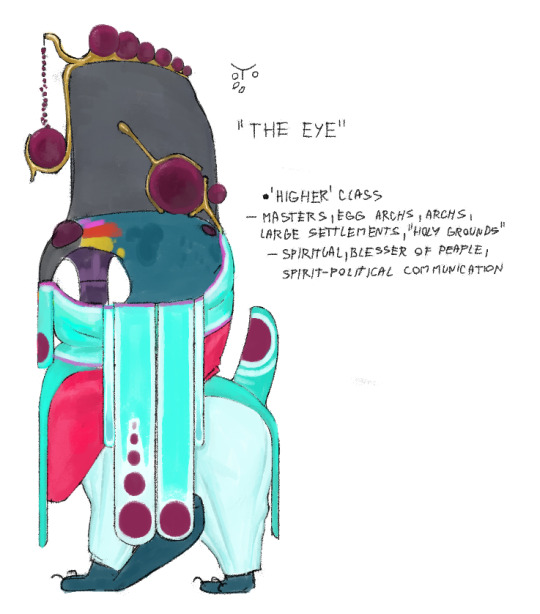
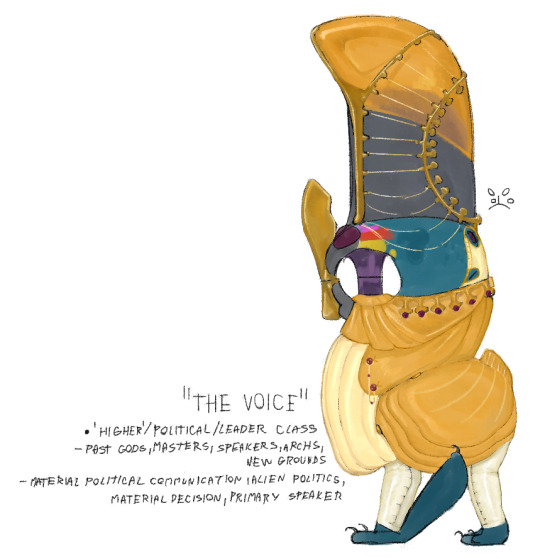
The Heads are the center of a religion practiced in the region.
In short - the Heads share one spirit that in ancient times belonged to a priest who misused their power to get to the spirit world and instead became forever stuck in the material world. After many reincarnations, the priest became a wise leader who learned to speak with the spirit world and make final peace between the worlds of spirits and the material.
I would need to go into more religion details to go over that but that can be a separate post. Let's talk about how they get their role.

A 'competition' is held to determine the best leader, most spiritually attuned, most well-thinking, and best-presenting individual. The Heads in position at the time with a few other high-ranking individuals will judge the participants and then make their pick at the choosing ceremony. Luckily there are not too many to choose from, there are many requirements to participate.
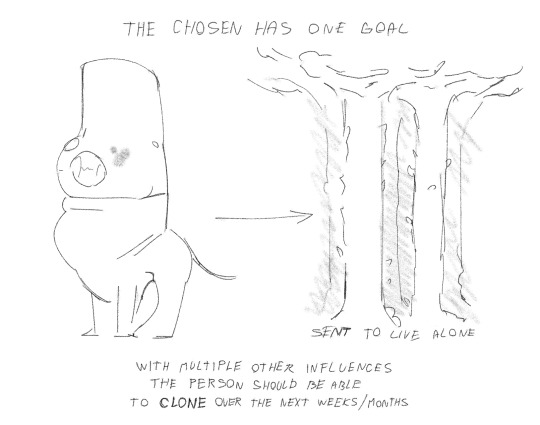
However, the one picked isn't one that will become a head, they would be far too old at the time. Instead, they will force their system to make a rare phenomenon happen. This means making more of themselves with cloning (having babies grow out of diploid cells with no need for another person). This is usually achieved when under high amounts of stress and loneliness.

The uniima egg naturally holds 4 larvae but usually only 1-2 develop fully while the rest becomes food for the surviving ones. This clone egg has 4 identical whites (pre-babies) in them that get special care to ensure at least 3 survive. There have been heads with one member before and with 2 and 3, but 4 is a miracle as the bottom corner larva almost never develops enough to hatch. This egg is very lucky.

The identical quadruplets are given to be raised in different environments. These environments will decide what they represent as adults. It will also give them better perspectives of the world, making it easier/more difficult to make big decisions when the time comes.
Additionally, because there are 4 heads this time, a new environment had to be introduced. This environment was that of small communities, minorities, and generally people living in poorer conditions (yes, for the past Heads, war was more important than their people suffering (it's a very central Foru thing)). Unfortunately for The Ear, they are not respected everywhere, and many people assume them to be a fake among their siblings.
You can also see the heads have each their own signature and each Head generation has their own symbol that is recognized outside their writing systems.
#art#speculative biology#artists on tumblr#digital art#artwork#worldbuilding#speculative evolution#uniima#spec bio#fantasy#goverment#religion#the heads#xenofiction#figures#speculative fantasy#culture#alienart#alien species#aliens#uniima c#spec evo#society
304 notes
·
View notes
Text
Creating fantasy religions: something I'm doing now so thought I would post about my process.
The mistake a lot of writers make is developing a religion from a singular event, and piling a ton of stuff on top of it that makes logical sense. Whereas, in reality, religions are self propelling systems that travel under their own steam and if there is an event that catalyses them, it is never in a socio-cultural or political and economic vacuum.
You also end up with an apparently totally random set of things attached to one figure which does make sense if you know the origins, but otherwise is just accepted even if the meaning is lost.
It is the difference between "the god of Midwinter and festivals around this originated because a cult of necromancers were banished into the frozen wastes and this <event> became the Origin Story for how we got to a midwinter festival with creepy bone puppets in my fantasy world" and a religion that feels ... Real.
Ok so firstly, this is a bit too neat. (This was my original reasoning for a midwinter god called Yarash and I changed it because it wasn't very realistic or interesting for my world.)
Why, let's say, is the god whose feast is at midwinter also the patron of puppet makers and osteopaths?
Well, we could say that this makes a lot of sense because the god's festival was originally to do with remembering the dead, and puppets were used in the festival to represent the dead, as necromancy should have been part of it but people didn't actually know how to raise the dead properly. Then as magic evolved people could actually raise the dead for short periods to deliver messages in these festivals, but this drew internal debate from the conservative priests who thought puppets were the original form and so should be maintained, and necromancy was an aberration, vs the progressives who saw necromancy as the original INTENTION and so the natural and correct progression from the puppets. The debate might rage on for years creating splinters, sects, differing traditions that sit uneasily together but find middle ground in other less controversial topics and practices, and even cults.
At some point, the secular authorities get involved for their own reasons. Maybe some rulers are pro-"The Old Bones" or anti-, or they want to outlaw necromancy or benefit from it for various political reasons, socio-cultural reasons, economic reasons, military intelligence reasons, etc. Whatever happens, happens. Times change. Official attitudes swing back and forth, while internally the religious debates continue, now informed by and perhaps as counters to, this secular intervention.
Then we end up in modern times, the times of the story. Nobody really believes in gods anymore. They do remember the old gods of the seasons and at the secular festival in winter, there are a lot of traditional puppet shows that have a whole history and life of their own. The puppets are called "the old bones" and nobody really remembers why. Osteopaths have the puppets and symbols relating to the midwinter festival on their certificates and college heraldry and nobody really remembers why, but the information is there to look up and is a fun thing to know for trivia nights.
And necromancy... is a controversial branch of science, divorced from its original religious significance for many but not for all, and more integrated as an art or practice in the public consciousness (positively or negatively depending on perspective and propaganda and actual usage).
And now, you have a ton of depth and meat to it without having to flesh out the arguments and debates themselves unless that is plot relevant.
There is a lot you can do with this society now, and by tweaking one thing you can create completely different societies and ideologies. The depth is now there to set your story at any point during this history and to develop numerous ideas. So much stuff can happen.
With the singular event version, and a static fact of a necromancy cult in the frozen wastes, things are much more limited and linear, with less depth to play with.
Also remember that your characters will not be expected to know everything about your world unless they are experts in religion and/or history, and also the 2 subjects are not mutually inclusive so a historian is not an expert theologian and vice versa. How much the average person on the street knows depends on levels of formal education, accessible knowledge beyond formal education, which may include religious instruction and folklore, and propaganda. But it means you can build in some subtle things - like the puppet symbols on the door of an osteopath or bone doctor - that never need to be explained, but have a logical in-world explanation below the surface.
Try taking a static idea and work it into a system and see where it leads!
#writeblr#worldbuilding#fantasy religion#writers on tumblr#writing community#writing tips#world building#writing fantasy#fantasy#fantasy writing
295 notes
·
View notes
Text
It's weird church lady hours in my TLT fixated brain, and I want to know what a sacrament is in the religion of the Nine Houses.
Because the terms "sacrament" and "sacramental" pop up a lot in HTN.
Much of Harrow's look seems to be made up of things described as sacramental: her face is painted with a "sacramental skull", the paints requiring appropriate blessing or otherwise are replaceable with blood. She wears sacramental vestments, and even the shorn heads of Ninth House cavaliers are described as "sacramentally shorn".
Most of that sounds very much like the Catholic concept of "a sacramental" - something that's a sign of a spiritual effect, like a blessed rosary, or making the sign of the cross. The painted face, the veiled head of the necromancer, or the shorn head of the cavalier being a sign of divine protection or blessing. Or perhaps those things are understood to be sacraments in and of themselves - outward signs of an inward grace, the blessed paint imparting some kind of spiritual power or effect in and of themselves from Jod or the Tomb. (Longer thoughts about Ninth veiling here)
Harrow prays to the Tomb before replacing Ianthe's arm, and thinks that she is going to "sacramentally adore" Ianthe's bones. (Is that what the kids are calling it these days?).
But a Lyctor is in themself apparently "a walking sacrament".
And then, of course, there's this quote from Jod:
You said... “The cavaliers—”
“Have joined their Lyctors,” he said. “It’s not really a lie. It’s simply a flattening of an awesome…and sacramental…truth."
It was around this point that I realised that Lyctors are like vampires.
The Catholic Church has seven sacraments, but the biggie is the eucharist, which Catholics believe is the actual transformation of bread and wine into the flesh and blood of Jesus, which are consumed by the faithful, uniting them with Him. And the ultimate goal is of course eternal life with God in Heaven.
Vampires have been understood as a sort of inversion of eucharistic theology: a demonic perversion of consuming flesh and blood to gain eternal life.
You can probably work out where this one is going with the immortals who hang out with the guy they think is god and whose powers come from consuming another person both spiritually and physically...
What's interesting about this in universe is that Jod is consciously interacting with concepts from Catholic theology, or at least was when he first decided to start his own special brand of sad girl necromantic space Catholicism. Not that he's particularly consistent with it, since he tells Harrow that Lyctorhood is both sacramental and an indelible sin... But at some point a conscious choice has been made on Lyctors and the concept of sacramentality. And while clearly the metaphysical world that Tamsyn Muir is imagining is one where the spiritual reality is not going to align with either Catholicism or with Jod's long con, the resonance of the vampire mythos feels very apropos.
As far as in world use goes, I want to know if they're just throwing around these terms to mean something like "holy" or if they relate to more specific practices within the religion of the Nine Houses? Are there defined sacraments? What does the religion of the Nine Houses even look like, outside of the Ninth? The Eighth seem to have a holy book and a practice of confession, there seem to be priests and religious orders aplenty even beyond the heretical Ninth, and there seems to be a concept of blessing and of intercessory prayer (but as Abigail Pent points out, there is apparently also no theology of omnipotence, though the jury is still out on omniscience and omnibenevolence, I guess).
#the locked tomb#tlt#john gaius#tlt meta#harrowhark nonagesimus#abigail pent#harrow the ninth#Once again I am overthinking#I just like worldbuilding ok#Overthinking House religion
175 notes
·
View notes
Text
Call me a hopeless goth, but I kind of like the Ninth House's funerary practices and I wish we knew more about them. At least, I like what they could be: what I imagine they once were, before their culture was shattered.
The Ninth as we see it is a civilization in its death throes. It's a utilitarian horror show, hollowed out by tragedy and stripped of all dignity and sentiment, but we have good reason to think it wasn't always like that. They have a history of fine textile production and poetry, and occassionally forming hero cults to celebrate cultural icons. There used to be families who raised their children communally. Before the sea of tiny coffins, the Ninth may have known how to live, and even how to mourn.
There are glimmers of what their death culture might have been like in Harrow's prayer beads: made from the bones of her ancestors, a tangible link to her history and community. And in Gideon searching for her mother in the leek fields, imagining that a woman she never met is still present in her life.
In a living culture with a functioning community, the use of human bone as a crafting material could make mundane objects into momentos, ways to keep loved ones close after their passing. The skeleton servitors could be seen as a way individuals continued to care and provide for the community, even after death.
If their dead are routinely exhumed to be added to the chore rota, it would make sense for the exhumation, cleaning, and raising of those bones to traditionally be a cultural ritual like a graduation or funeral. Most of those skeletons would have had living friends and family working alongside them, when the Ninth still had generations. The skeleton sweeping the chapel used to be someone's uncle. People in these cultures do mourn death. We've seen them with the corpses of people they knew, and they're not completely desensitized; just very weird. There's a throw-away line once about Harrow having a pet peeve about personalising the skeletons, which means it must be fairly common to do that. What was to stop previous generations of the Ninth from getting scolded for putting funny hats on Cousin Balbus's bones? Nothing, that's what. Balbus liked hats, anyway, so I don't see how it was disrespectful.
I'm sure Wake didn't get a ceremony when she was raised as a servitor; the main beneficiary would have been Gideon, and god fucking knows no one ever went out of their way to make her feel like part of the community. I'm betting no one does raising ceremonies for anyone, anymore. The Ninth is as good as dead, and no one ever taught the youngest generation how to mourn. But for ten thousand years, the Ninth successfully lived in very close proximity to mundane natural death. It's fun to imagine what that looked like.
#the locked tomb#gideon the ninth#tlt worldbuilding#like.... the Ninth is based sort of on a medieval Christian monastary#in the small personal living quarters heavy emphasis on religion and communal living spaces#medieval monastaries were full of culture and gossip and functioned as a fairly close community#and when you factor in that the Ninth was hereditary and one of the commmunal duties was childrearing....#you get something much closer to a smallish tribe or clan#the prayer of the Locked Tomb has been passed down unchanged for almost ten thousand years#that takes INTENSE social cohesion and a strong commitment to cultural ritual#the amount of Ninth culture we will never know because we came in after their extinction event.... man....
1K notes
·
View notes
Text
Do the people of your world leave offerings? If so, who to? What kind of ojects are typically offered?
93 notes
·
View notes
Text
Your a dimensional traveler, and you begin to realize that the same handful of religions in every dimension. Like, the same gods and belief systems seem to repeat. Earth has most of them but there are a few that haven't hit us yet.
Some of them make sense, like there's a dimension of endless night, that's mostly forests and maze like modern cities, which are inhabited by these eldrich farie/cryptid/creepypasta beings. And most of them seem to worship either the Celtic or Aztec pantheons, with a handful of catholics, which kind of checks out knowing their vibe.
But then there are weird ones like a very low magic world with medieval technology having scientology and wiccanism as their main two religions, just because those are the two that began to spread in this region the most rapidly. Oftentimes there will be rival dynasties between kingdoms of those two religions.
You've been to a dimension where humanity is an all female race, where you learned chrsitantiy was common. But the entire religion feels diffrent because of how sex and reproduction work in that world, and their version of the Bible is just diffrent enough to weird you out. It's also weird seeing how they depict Jesus, especially amoung the minority of their population that has cat ears.
There's a dimension of robots, where no biological life exists, where you learned worship of the hellenic pantheon was common. But the aspects of the gods and the way they see them as working is very inherently diffrent for mechanical beings. But you can still see that there are fundamental parts of those gods that are still there in your world too.
Eventually you meet something eldritch, a being of higher knowledge, that's nearly incomprehensible to humanity. It has a thousand eyes, and a hunder arms, and towers above you. It's something someone more naive to the multiverse would call a god. You ask it what religion it thinks is true, and it replies that from where it stands all of them are, and that all gods coexist. That feels about right, and you ask it if it follows any as it's own truth, the eldritch horror replies that it was raised Jewish, but it doesn't really practice the faith anymore unless it's with its mother. This confuses you more.
#196#my thougts#worldbuilding#fantasy#writing#my worldbuilding#urban fantasy#my writing#religion#theology#dimensions#robot#robots#catgirl#eldritch#eldrich horror#pagan#paganism
108 notes
·
View notes
Text
After her passing, Queen Pearl’s armor was buried in the gardens outside of her house. A gravemarker was made from granite, a sun and a goose carved into the stone face along with her name.
But, well, there was a kingdom to rebuild and burnt hones and scorched crops didn’t repair themselves for a queen’s death. The people banded together to figure out some form of government and then set out to fix up their kingdom.
The first harvest after the fires was bountiful.
The Helanthians would give Queen Pearl’s spirit the credit for that. Her soul had returned to the lands and was helping them flourish even after death.
It became custom then, over the years, to ask the spirit of Queen Pearl for advice or assistance or for good crops. Usually, she delivered. Several generations went, and the new Helanthians hadn’t known Queen Pearl outside of the history books, but her deeds were written down dutifully. They knew she was someone who really deserved a little acknowledgment every here and again.
Years passed. It became tradition to leave out small offerings in your fields to thank Queen Pearl for her help. Roasted sunflower seeds, cups of ale, fresh baked bread, turkey legs, whatever you could spare and was good. Eventually this expanded to add small golden trinkets, flowers, things around the house you didn’t mind giving up and were good. People started building small temples in their fields to house these offerings without getting them dirty and attracting all sorts of scavenger birds.
Generations passed. The people and culture spread as it tends to do. New history books are written.
Queen Pearl is very often interpreted as a god or a metaphor rather than a once-living spirit. After all, what sort of human can laugh off a demon’s attacks or find their soul connected with the soils of her kingdom? She’s given other names, mostly translation error. They call her Peril, Mother of Sunflowers, Harvestqueen, War-Maiden, and more.
Stories of her deeds are spread as myths and folklore. They say she challenged a demon twice and won both times. They say nobody could defeat her in battle. They say she was the fires that burnt down Old Helanthia. They say she took a champion who never left her side, a nameless king from an ancient kingdom. They say she gained her power from the moon or from the sun or from both. They say she could wield a scythe as well as a sword.
Her image is, quite frankly, never the same from place to place. There were portraits of her, but they’re ancient and in need of restoration. Some give her a vulture’s wings to symbolize her brutal nature. Some give her a halo of sunlight to show her affinity for farming. They all dress her in green and surround her in sunflowers.
Whatever name or face she is given, she is spread along with the descendants of the people who walked and talked with her. She stays in the hearts of the Helanthians. Whether she is the Harvestqueen bringing prosperity to the farmers, or Peril charging into battle with the bravest of soldiers. They know her and tell her mythos to their children and paint her legends to hang in temples or museums.
And this is how a woman becomes a god.
#empires smp#worldbuilding my beloved#u can imagine like the og helanthians believing she’d become a friendly local spirit in death#and then after years of culture evolving and people moving and cultural exchanges happening#she becomes a part of an actual religion#oohogogiffjfjdjsajsj
717 notes
·
View notes
Text
Standard fantasy RPG pantheon, except:
each god is also the patron of one of the setting's local city-states, and each city-state espouses their own version of the pantheon's org chart that positions their patron as King or Queen of the Gods. The gods themselves decline to weigh in on who's correct.
the god of war died in a bizarre trebuchet accident several decades previously; a coalition of other gods have been playing Weekend at Bernie's with their priesthood ever since, doing their best to answer their prayers with variable plausibility and success.
there are two separate gods of knowledge with two separate, non-overlapping cults. Each god's cult is apparently unaware of the other's existence. There's nothing obviously supernatural about this separation; they just never seem to bump into each other.
the supreme god of the Nice Pantheon of Goodness and Light and the supreme god of the Icky Pantheon of Evil and Darkness are clearly the same guy wearing two different hats. Most NPCs react to having this pointed out as though it's obviously absurd.
the obligatory Squiddy Alien Gods From Beyond The Stars are treated as just another branch of the pantheon alongside the usual faux-Greek deities. Nobody thinks it's at all odd that the god of thunder's sworn blood-sibling is a shapeless cloud of blazing eyes.
#concepts#gaming#tabletop roleplaying#tabletop rpgs#worldbuilding#game design#religion#violence mention#death mention
6K notes
·
View notes
Text
Depicting Real World Religions Alongside Constructed Religions
Maya asked:
Hi WWC! Thank you so much for this blog, it's an infinitely wonderful resource!
Do you have any suggestions for how I can balance representation of real religions with fantasy religions, or should I avoid including these together? Does the fact that certain things bleed over from our world into the fantasy world help legitimize the appearance of real world religions?
I feel like I can come up with respectful ways to integrate representation in ways that make sense for the worldbuilding. For instance, no Muslim characters would practice magic, and both Jewish and Muslim characters would conceive of magic in ways that fit their religion (rather than trying to adapt real religions to fit my worldbuilding).
I also have some ideas for how these religions came about that fit between handwave and analogous history (though I realize the Qur'an is unchangeable, so I'm guessing Islam would have come about in the same way as IRL). BTW—I'm referring to humans, not other species coded as Muslim or Jewish. I may explore the concept of jinns more (particularly as how Muslims perceive fantastical beings), but I definitely need to do a lot more research before I go down that road!
Finally, I saw a post somewhere (*but* it might have been someone else's commentary) suggesting to integrate certain aspects of Judaism (e.g., skullcaps in sacred places/while praying, counting days from sundown instead of sunset) into fantasy religions (monotheistic ones, of course) to normalize these customs, but as a non-Jewish person I feel this could easily veer into appropriation-territory.
*One of the posts that I'm referring to in case you need a better reference of *my* reference: defining coding and islam-coded-fantasy
[This long ask was redacted to pull out the core questions asked]
"Both Jewish and Muslim characters would conceive of magic in ways that fit their religion (rather than trying to adapt real religions to fit my worldbuilding)."
Just a note that while having religion be part of magic is a legitimate way to write fantasy, I want to remind people that religious characters can also perform secular magic. Sometimes I feel like people forget about that particular worldbuilding option. (I feel this one personally because in my own books I chose to make magic secular so that my nonmagical heroine wouldn’t seem less close to God somehow than her wizard adoptive dad, who is an objectively shadier person.) I’m not saying either way is more or less correct or appropriate, just that they’re both options and I think sometimes people forget about the one I chose. But anyway moving on—
Your decision to make the water spirits not actual deities is a respectful decision given the various IRL monotheistic religions in your story, so, thank you for that choice. I can see why it gets messy though, since some people in-universe treat those powers as divine. I guess as long as your fantasy Jews aren’t being depicted as backwards and wrong and ignoring in-universe reality in favor of in-universe incorrect beliefs, then you’re fine…
"I saw a post somewhere (but it might have been someone else's commentary) suggesting to integrate certain aspects of Judaism (e.g., skullcaps in sacred places/while praying, counting days from sundown instead of sunset) into fantasy religions (monotheistic ones, of course) to normalize these customs, but as a non-Jewish person I feel this could easily veer into appropriation-territory."
That was probably us, as Meir and I both feel that way. What would make it appropriative is if these very Jewish IRL markers were used to represent something other than Judaism. It's not appropriative to show Jewish or Jewish-coded characters wearing yarmulkes or marking one day a week for a special evening with two candles or anything else we do if it's connected to Jewishness! To disconnect the markers of us from us is where appropriation starts to seep in.
–Shira
To bounce off what Shira said above, the source of the magic can be religious or secular--or put another way, it can be explicitly granted be a deity or through engagement with a specific religious practice, or it can be something that can be accessed with or without engaging with a certain set of beliefs or practices. It sounds like you’re proposing the second one: the magic is there for anyone to use, but the people in this specific religion engage with it through a framework of specific ideas and practices.
If you can transform into a “spirit” by engaging with this religion, and I can transform into a “spirit” through an analogous practice through the framework of Kabbalah, for example, and an atheist can transform through a course of secular technical study, then what makes yours a religion is the belief on your part that engaging in the process in your specific way, or choosing to engage in that process over other lifestyle choices, is in some way a spiritual good, not the mechanics of the transformation. If, on the other hand, humans can only access this transformative magic through the grace of the deities that religion worships, while practitioners of other religions lack the relationship with the only gods empowered to make that magic, that’s when I’d say you had crossed into doing more harm than good by seeking to include real-world religions.
Including a link below to a post you might have already seen that included the “religion in fantasy worldbuilding alignment chart.” It sounds like you’re in the center square, which is a fine place to be. The center top and bottom squares are where I typically have warned to leave real-world religions out of it.
More reading:
Jewish characters in a universe with author-created fictional pantheons
–Meir
733 notes
·
View notes